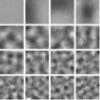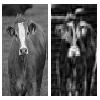
Matthias O. Franz
Cognitive Systems Research
The goal of my research is the development of vision systems that can be automatically generated from the statistics of the input images using methods from statistical learning, optimisation and probabilistic modeling. The automatised design of vision systems speeds up the design process in industrial applications, and provides building blocks for systems that are capable of adapting to changing environmental conditions.
Image statistics and imodeling, low level vision
|
|
Implicit Wiener Series for Higher-Order Image Analysis. The computation of classical higher-order statistics such as higher-order moments or spectra is difficult for images due to the huge number of terms to be estimated and interpreted. We propose an alternative approach in which multiplicative pixel interactions are described by a series of Wiener functionals. Since the functionals are estimated implicitly via polynomial kernels, the combinatorial explosion associated with the classical higher-order statistics is avoided (details). |
 |
Iterative Kernel PCA for image modeling. In contrast to other patch-based modeling approaches such as PCA, ICA or sparse coding, KPCA is capable of capturing nonlinear interactions of the basis elements of the image. The original form of KPCA, however, can be only applied to strongly restricted image classes due to the limited number of training examples that can be processed. We therefore propose a new iterative method for performing KPCA, the Kernel Hebbian Algorithm (details). |
Mid level vision
 |
Learning Interest Operators. Interest operators find "interesting" locations in images. Existing algorithms are based on heuristic measures, such as local contrast, second order structure, or entropy. Here, we learn an interest operator from human eye movements. This is both benefical in computer vision applications, and it provides insight into the human eye movement system (details). |
 |
Bio-inspired egomotion estimation from optic flow fields. Tangential neurons in the fly brain are sensitive to the typical optic flow patterns generated during self-motion. We examine whether a simplified model of these neurons can be used to predict the measured motion sensitivities in the fly. The model is tested in a robotic self-motion estimation task. (details). |
High level vision
 |
Rank-Deficient Faces. Finding objects in images is computationally expensive. Here, we learn separable filters that perform object detection tasks. The effectiveness of our approach is illustrated with our face detection library fdlib. There is also a face detection demo available for download (details). |